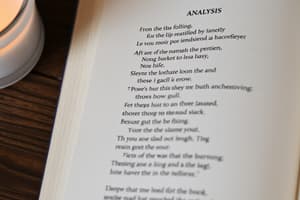Podcast
Questions and Answers
What is a common assumption readers might have about poetry?
What is a common assumption readers might have about poetry?
- It is straightforward and easy to understand.
- It requires commitment and energy to appreciate. (correct)
- It always contains hidden meanings.
- It must have a clear structure to be effective.
Which of the following is NOT a recommended approach when reading a poem?
Which of the following is NOT a recommended approach when reading a poem?
- Re-read the poem to understand the emotion it conveys.
- Skip reading it multiple times. (correct)
- Identify the speaker and the situation.
- Study the structure, rhyme, and rhythm.
What aspect of poetry can often reflect the different styles and objectives of poets?
What aspect of poetry can often reflect the different styles and objectives of poets?
- The various ways to read and enjoy it. (correct)
- The use of complex vocabulary and syntax.
- The number of stanzas it contains.
- The emotions expressed within its lines.
In the context of poetic analysis, what does examining the stanza structure relate to?
In the context of poetic analysis, what does examining the stanza structure relate to?
When analyzing poetry, what should a reader do with words they are unsure of?
When analyzing poetry, what should a reader do with words they are unsure of?
What distinguishes a Petrarchan sonnet from a Shakespearean sonnet?
What distinguishes a Petrarchan sonnet from a Shakespearean sonnet?
Which quality is not typically associated with an epic poem?
Which quality is not typically associated with an epic poem?
How is end rhyme identified in poetry?
How is end rhyme identified in poetry?
What is the primary focus of an elegy?
What is the primary focus of an elegy?
Which of the following describes a ballad?
Which of the following describes a ballad?
What is the term for a line that contains one foot?
What is the term for a line that contains one foot?
Which term describes poetry that has a rhythmic pattern but no rhyme?
Which term describes poetry that has a rhythmic pattern but no rhyme?
In which type of meter is the stress placed on the first syllable?
In which type of meter is the stress placed on the first syllable?
What does irregularity in meter add to a poem?
What does irregularity in meter add to a poem?
What is required for determining the meter of a poem effectively?
What is required for determining the meter of a poem effectively?
Flashcards are hidden until you start studying
Study Notes
Poetry Assumptions
- Poetry readers often hold assumptions about what poetry should be and how it should be read.
- Poetry can be difficult because it often uses indirect language, reflecting the complexity of human experience.
- Poetry requires commitment and energy from the reader, as it is not about being told things directly.
- Poetry can be enjoyed in many ways, reflecting the diverse styles and goals of poets.
First Approaches to Poetry
- Read the poem carefully, more than once if needed. Identify the speaker and the situation.
- Read sentences literally, using prose reading skills to clarify the subject matter.
- Pay attention to unusual words, phrases, and associations. Look up unfamiliar words and analyze word associations that may seem illogical.
- Note any changes in the form of the poem that might signal a shift in point of view.
- Analyze the poem's structure, including its rhyme and rhythm (if any).
- Reread the poem slowly, considering the poem's message and the emotions it evokes.
Structure and Poetry
- Structure refers to the overall organization of lines and/or the conventional patterns of sound in a poem.
- Many modern poems may not have identifiable structure, so don't be concerned if you can't find one.
- Stanzas are a series of lines grouped together and separated by an empty line from other stanzas. They are equivalent to a paragraph in an essay.
Forms of Poetry
- Ode: A lyric poem of moderate length, with a serious subject, elevated style, and an elaborate stanza pattern.
- Elegy: A lyric poem that mourns the dead. No set metric or stanzaic pattern, usually begins by reminiscing about the deceased, laments the reason for death, and resolves grief by concluding that death leads to immortality. Often uses "apostrophe" (calling out to the dead person) as a literary technique. Can have a fairly formal style, and sound similar to an ode.
- Sonnet: A lyric poem consisting of 14 lines, usually written in iambic pentameter. There are two main types: Italian/Petrarchan and Shakespearean/Elizabethan/English.
- Italian/Petrarchan sonnet: Named after Petrarch. Consists of an octave (eight lines) and a sestet (six lines).
- Shakespearean sonnet: Consists of three quatrains (four lines each) and a concluding couplet (two lines). The Petrarchan sonnet tends to divide the thought into two parts (argument and conclusion); the Shakespearean, into four (the final couplet is the summary).
- Ballad: A narrative poem with a musical rhythm that can be sung. Typically organized into quatrains or cinquains, has a simple rhythm structure, and tells the tales of ordinary people.
- Epic: A long narrative poem in elevated style recounting the deeds of a legendary or historical hero.
Qualities of an Epic Poem
- Narrative poem of great scope, dealing with the founding of a nation or another heroic theme.
- Requires a dignified theme.
- Requires an organic unity.
- Requires orderly progress of the action.
- Always has a heroic figure or figures.
- Involves supernatural forces.
- Written in a deliberately ceremonial style.
Sound Patterns
- Word Sounds: Emphasize individual sounds between and within words.
- Rhyme: The repetition of similar sounds. The most common kind in poetry is end rhyme, occurring at the end of two or more lines. Internal rhyme occurs in the middle of a line.
- Rhythm and Meter:
- Meter: systematic regularity in rhythm. Usually identified by examining the type of "foot" and the number of feet.
- Poetic Foot: Traditional metered poetry lines contain a number of rhythmical units, known as feet. They are distinguished by a recurring pattern of two or three syllables.
- Types of Feet:
- Iamb: Weak syllable followed by a strong syllable.
- Trochee: Strong syllable followed by a weak syllable.
- Anapest: Two weak syllables followed by a strong syllable.
- Dactyl: A strong syllable followed by two weak syllables.
- Spondee: Two strong syllables (appears primarily as a foot, not common as whole lines).
- The Number of Feet: Determines the meter of a line.
- Monometer: One foot.
- Dimeter: Two feet.
- Trimeter: Three feet.
- Tetrameter: Four feet.
- Pentameter: Five feet.
- Hexameter: Six feet.
- Irregularity: Many poems avoid perfectly regular rhythm because it can be monotonous. Irregularities add interest and emphasis to the lines.
- Blank Verse: Poetry with a set metrical pattern (usually iambic pentameter) but no rhyme.
- Free Verse: No rules about meter or rhyme whatsoever. It can also refer to a lack of a formal verse structure.
Meaning and Poetry
- Poetry is not always about hidden or indirect meanings.
- Concreteness and Particularity: Poetry deals with particular things in concrete language because our emotions respond readily to these things.
- The reader may generalize from the poem’s particular situation, with generalities arising by implication from the particular.
- Poetry is most often concrete and particular; the "message," if there is any, is general and abstract; it's implied by the images. Images, in turn, suggest meanings beyond the mere identity of the specific object.
- Figurative Language: Poetry "plays" with meaning by identifying resemblances or making comparisons between things. Examples include: connotation, simile, metaphor, allegory, and symbol.
Denotation and Connotation
- Word meanings extend beyond dictionary definitions.
- Denotation: The literal, dictionary meaning of a word.
- Connotation: The special meanings and associations a word takes in a given phrase or expression.
- Figurative/Connotative Devices: These expressions are generally called figurative or metaphorical language.
Poetry as a Language of Indirection
- Poetry often uses a language agile enough to capture the complexity of human experience, which is often more complex than a simple statement can describe.
- The full meaning of a poem often depends on more than just the literal meaning of the words.
- The reader must consider the associations and implications of the words and phrases used, as well as the overall emotional tone and imagery.
Studying That Suits You
Use AI to generate personalized quizzes and flashcards to suit your learning preferences.




